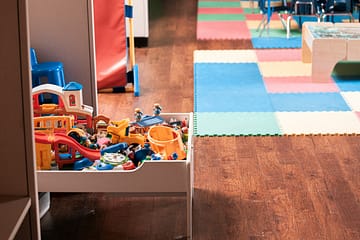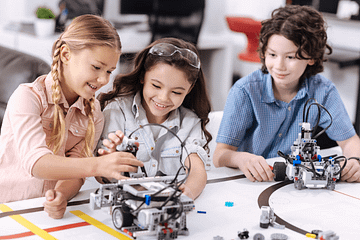What should you get for a child? Should it be educational toys that promise to enhance his brains, or action figures and toy vehicles that provide hours of entertainment? It may be difficult for a parent to strike the appropriate balance between learning and play. The good news is you don’t have to pick between the two. It might be both. Choosing toys for a youngster necessitates a strategic strategy that stresses growth and enjoyment. Allow each individual’s particular interests and requirements to drive your selection of toys that are both fun and instructive. Creativity is essential; there are innumerable toys that smoothly combine learning and entertainment. Play is essential for all children, but it is particularly critical for neurodiverse children. Unconventional toy use and open-ended play can help young children gain important abilities in areas where they may struggle.
You might assume that toys are only for fun and games. However, play accomplishes far more than simply entertain children. It enables youngsters to explore, create, problem solve, and practice social skills. What about all that “unstructured” playtime? It quietly allows kids to practice everything from fine motor skills to emotional moderation. Neurodivergent children frequently interact with objects in unusual ways. What appears to you as “misusing” a toy may actually be a type of unconventional thinking. Perhaps your youngster should line up vehicles rather than push them about. Or concentrates solely on spinning a toy’s wheels rather than playing with it as designed. These unusual play patterns may suggest significant areas of interest. They may even discover hidden skills! Instead of redirecting, observe your child’s natural interactions with various toys. These insights are crucial for developing their potential.
Sparking Imagination and Creativity
When children are allowed the opportunity to use toys in unusual ways, they discover a world of imagination and creativity. Rather of being limited to their “intended” usage, they may reuse items and create totally new scenarios. From a young age, this form of unstructured play strengthens their imagination muscles and fosters creative thinking. This flexibility is extremely beneficial for neurodiverse youngsters who may struggle with strict thought processes. It allows people to break away from preconceived notions and explore new thoughts and possibilities. Who knows what new solutions they could develop in the future?
Building Problem-Solving Prowess
Unconventional play is similar to a tough problem that children may solve creatively. When youngsters utilize a toy in an unconventional way, they are continuously confronted with new issues to solve. How can they make this block resemble a car? How will they reuse this doll accessory?
As learners go through these mini-challenges, they are improving their problem-solving talents. They learn to approach problems from several perspectives, become inventive, and continue until they find a solution that works. These essential abilities will help students succeed academically, professionally, and in life.
Encouraging Self-Expression and Confidence
For many neurodiverse children, traditional standards and expectations can be obstructive. Unconventional play offers a judgment-free environment in which kids may just be themselves. They may freely express their individual interests, strengths, and opinions while playing with open-ended toys. This independence promotes self-esteem and self-expression. Children feel liberated to think differently, accept their unique characteristics, and boldly express their wonderful ideas. Over time, this might make individuals more comfortable taking creative chances and sticking out from the pack.
Recommendations for Choosing the Right Toys
When choosing toys for neurodiverse children like Timmy, it is critical to explore alternatives that combine fun and educational value while also responding to their specific sensory demands. Here are some creative and practical tips to help you select the best toys:
New Adventures for Stuffed Friends
Those adorable toy animals can become more than simply huggable friends.
– Act out social stories with your child to help them grasp emotions and practice communication. Give each plush animal a particular emotion and discuss several scenarios.
– Incorporate Sensory Play: Enhance the experience by stroking the toys’ fur or allowing them to contact other textures. This can provide a relaxing and interesting sensory experience.
Sensory Experience
Every child has different sensory demands and preferences:
– Customize Toys: Enhance sensory experiences by adding textured fabrics, crinkly materials, or even scented aspects to regular plush animals. This modification has the potential to create an infinite number of interesting sensory play experiences.
Adapt Board Games
Board games may be an excellent approach to improve a variety of skills:
– Simplify Gameplay: Remove complicated rules to accommodate smaller children or those with developmental difficulties.
– Incorporate Tactile Elements: Textured dice or gaming pieces can enhance the tactile experience.
– Visual Supports: Use visuals to reinforce topics and improve comprehension. These minor adjustments may make board games more entertaining and accessible.
Simple Toy Hacks
Create engaging toys with everyday items:
– Make your own shakers by filling empty plastic bottles with dried pasta, beads, or bells.
Pretend Play Scenes: To encourage imaginative play, decorate cardboard boxes into castles or rocket ships.
– Pool Noodle Snakes: Cut pool noodles into flexible, bending “snakes” for endless entertainment. These projects are affordable and adaptable to your child’s shifting interests.
Combining Toys for Multi-Sensory Play
For children with sensory demands, engaging many senses at the same time is essential.
– Texture Exploration: Mix and mix toys with different textures, such as soft plushies, spiky fidget toys, and squishy stress balls. Encourage your kid to investigate and explain these tactile feelings, which can help them expand their vocabulary.
– Sounds and Sights: Combine musical instruments with visually exciting toys such as disco balls and light-up wands. Encourage your toddler to move to the beat while admiring the brilliant lights and patterns.


